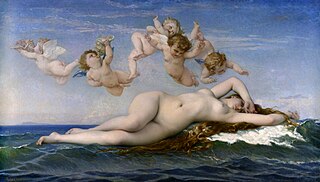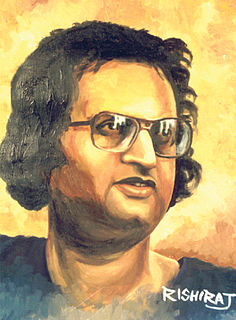Related Research Articles

Academic art, or academicism or academism, is a style of painting, sculpture, and architecture produced under the influence of European academies of art. Specifically, academic art is the art and artists influenced by the standards of the French Académie des Beaux-Arts, which was practiced under the movements of Neoclassicism and Romanticism, and the art that followed these two movements in the attempt to synthesize both of their styles, and which is best reflected by the paintings of William-Adolphe Bouguereau, Thomas Couture, and Hans Makart. In this context it is often called "academism," "academicism," "art pompier" (pejoratively), and "eclecticism," and sometimes linked with "historicism" and "syncretism."

Elaine Marie Catherine de Kooning was an Abstract Expressionist and Figurative Expressionist painter in the post-World War II era. She wrote extensively on the art of the period and was an editorial associate for Art News magazine.

Arthur Wesley Dow was an American painter, printmaker, photographer and influential arts educator.

Liu Kang was a Singaporean artist known for his Balinese-themed figurative paintings. He was a founding member of the Singapore Art Society, and was credited with developing the Nanyang Style, an art style associated with the Nanyang Academy of Fine Arts. He is also the father of the architect Liu Thai Ker.
Fua Haripitak was a celebrated Thai artist.

Wu Guanzhong was a contemporary Chinese painter widely recognized as a founder of modern Chinese painting. He is considered to be one of the greatest contemporary Chinese painters. Wu's artworks had both Western and Eastern influences, such as the Western style of Fauvism and the Eastern style of Chinese calligraphy. Wu had painted various aspects of China, including much of its architecture, plants, animals, people, as well as many of its landscapes and waterscapes in a style reminiscent of the impressionist painters of the early 1900s. He was also a writer on contemporary Chinese art.

Chen Chong Swee was a Singaporean watercolourist belonging to the pioneer generation of artists espousing the Nanyang-styled painting unique to Singapore, at the turn of the 20th century. He was also one of the first artists in Singapore to use Chinese ink painting techniques to render scenery and figurative paintings of local and Southeast Asian themes.

Chen Wen Hsi was a Chinese-born Singaporean artist, known for his avant-garde Chinese paintings.

Chua Ek Kay was a Singaporean artist hailed as the "bridge between Asian and Western art" with a unique painting style using Chinese ink on paper that demonstrated an ingenious blend of traditional Chinese painting forms with Western art theories and techniques. Most of his works were themed of Chinatown street scenes, lotuses, and abstract works inspired by Australian aboriginal cave paintings.

Lim Hak Tai was one of Singapore's pioneer artist at the turn of the 20th century, and was the person who inspired the Nanyang School of art form, to reflect the 'Nanyang' region, both in painting style and subject matter.
Group 90 is an informal arts group in Singapore, committed to the study and interpretation, and promotion of the human nudity as an art form. It was founded the late Brother Joseph McNally, along with founding members S. Namasivayam, Chia Wai Hon and Sim Tong Khern, who subscribe to the European art tradition of using the human body in developing artistic mastery in depicting form, perceptual acuity and fluency in drawing.

Georgette Chen Li Ying, born Chang Li Ying was a Singaporean painter known for her Post-Impressionistic styled oil paintings at the turn of the 20th-century. She was a pioneer of the visual arts in Singapore, who contributed to the birth of the Nanyang art style in Singapore. Chen also joined the Nanyang Academy of Fine Arts in 1954 as a teacher and lecturer until her hospitalisation. She was also the first woman to teach at the Nanyang Academy of Fine Arts (NAFA), and also the only one schooled in Paris, France.
Yong Mun Sen was a Malaysian artist and one of the founder of Nanyang Academy of Fine Arts in Singapore, then Malaya. Born Yong Yen Lang in Kuching, Sarawak, he changed his name to Yong Mun Sen in 1922.

Bikash Bhattacharjee was an Indian painter from Kolkata in West Bengal. Through his paintings, he depicted the life of the average middle-class Bengali – their aspirations, superstitions, hypocrisy and corruption, and even the violence that is endemic to Kolkata. He worked in oils, acrylics, water-colours, conté and collage. In 2003, he was awarded the highest award of Lalit Kala Akademi, India's National Academy of Arts, the Lalit Kala Akademi Fellowship.

Mohammad Din Mohammad is a Singaporean Malay painter who is known for his expressive works of art inspired by Sufism. Mohammad's paintings and sculptures are also heavily influenced by his devotion to the practice of the Malay martial arts called silat. He was also a practising bomoh, or Malay healer.
Richard Winther was a Danish artist. His career focused mainly on painting, graphics, photography and sculpture. Richard's work was greatly influenced by Asger Jorn and Richard Mortensen, both Danish artists part of the Linien group.
Nanyang Style is a regional art movement expressed solely in the form of visual art. The first attempts to define the Nanyang Style were made by art historians, Redza Piyadasa and T.K. Sabapathy, in 1979, during a retrospective study of Nanyang artists’ works. This study was done in tribute to the Nanyang Academy of Fine Arts (NAFA). The Nanyang style of painting was practised by migrant Chinese painters in Singapore in the 1950s.
Faraj Abbo al Numan, more commonly Faraj Abu, Faraj Aboo or simply Faraj Abou, was an influential Iraqi artist, theatre director, designer, author and educator, noted as one of the early artists to integrate Arabic script into his abstract paintings and who achieved international recognition for his artwork.
Ho Kah Leong is a former Singaporean politician and was a member of the People's Action Party (PAP). He was the Member of Parliament (MP) for Jurong Single Member Constituency (SMC) from 1966 to 1997. After retirement from politics in December 1996, he became the principal of Nanyang Academy of Fine Arts (NAFA) from 1997 to 2003, and Executive director of NAFA International Pte Ltd from 2003 to 2005.
Salleh Japar is a Singaporean contemporary artist working across sculpture, installation and painting, with his work coming into prominence in late 1980s Singapore. Within Singapore's history of contemporary art, Salleh is known for his collective work with Goh Ee Choo and S. Chandrasekaran for the seminal 1988 exhibition, Trimurti. In 2001, Salleh was one of four artists selected to represent at the very first Singapore Pavilion at the prestigious 49th Venice Biennale, alongside artists Henri Chen KeZhan, Suzann Victor, and Matthew Ngui.
References
- 1 2 Art Invitational (PDF), Art Outreach Singapore, 2005, p. 15, retrieved 2009-01-29
- 1 2 Poh Siew Wah: Biography, Singapore: Nanyang Academy of Fine Arts, archived from the original on 2011-07-14, retrieved 2009-01-29
- ↑ Sheares, Constance, "Poh Siew Wah: an introduction", Poh Siew Wah, Singapore: Hansa Lithographers, pp. 3–11
- ↑ Tan, Bridget Tracy; Lim, Iris, eds. (2008), Nanyang 70 years after - a reunion of artists in the academy, Singapore: Nanyang Academy of Fine Arts, pp. 114–115, ISBN 978-981-08-2057-2